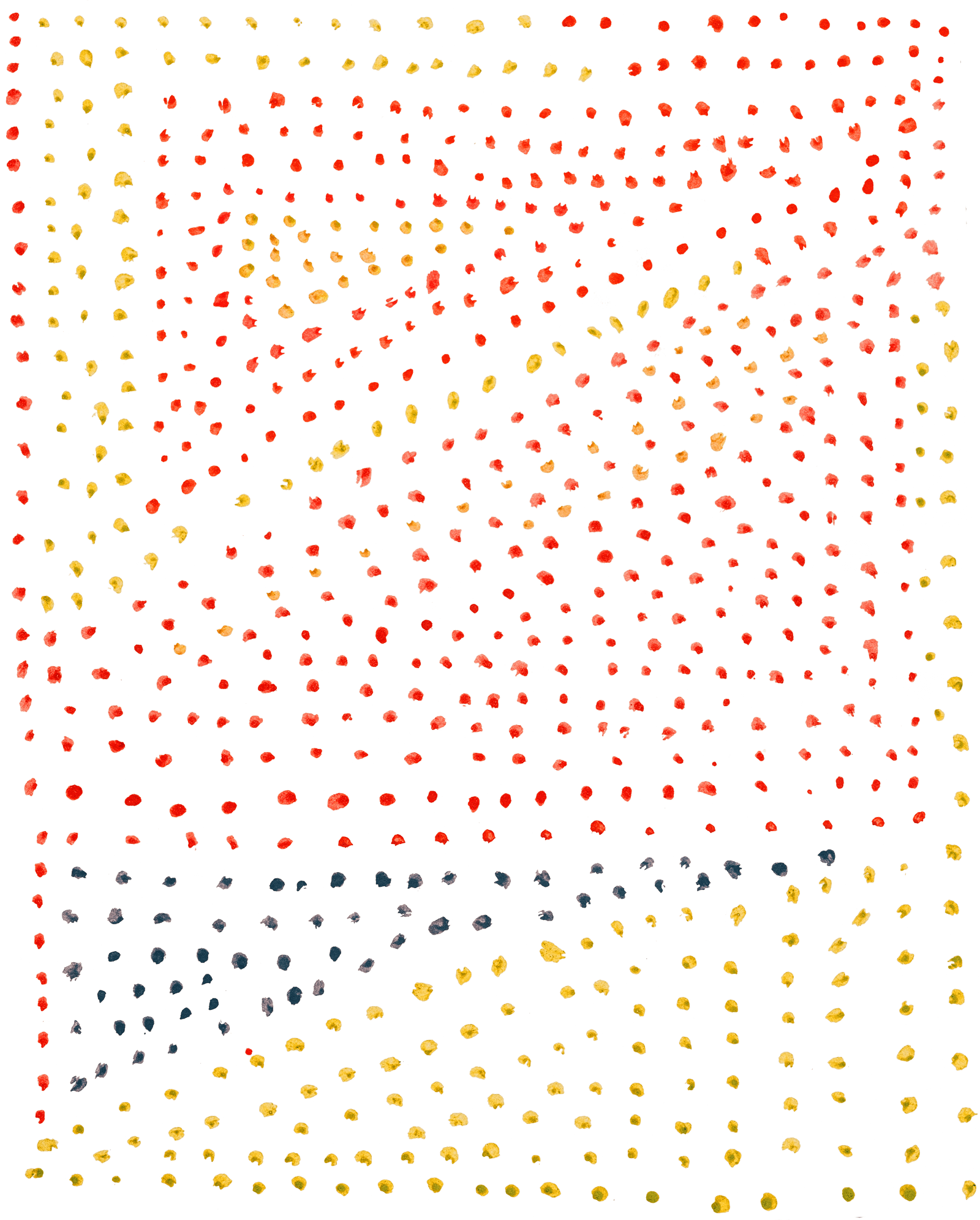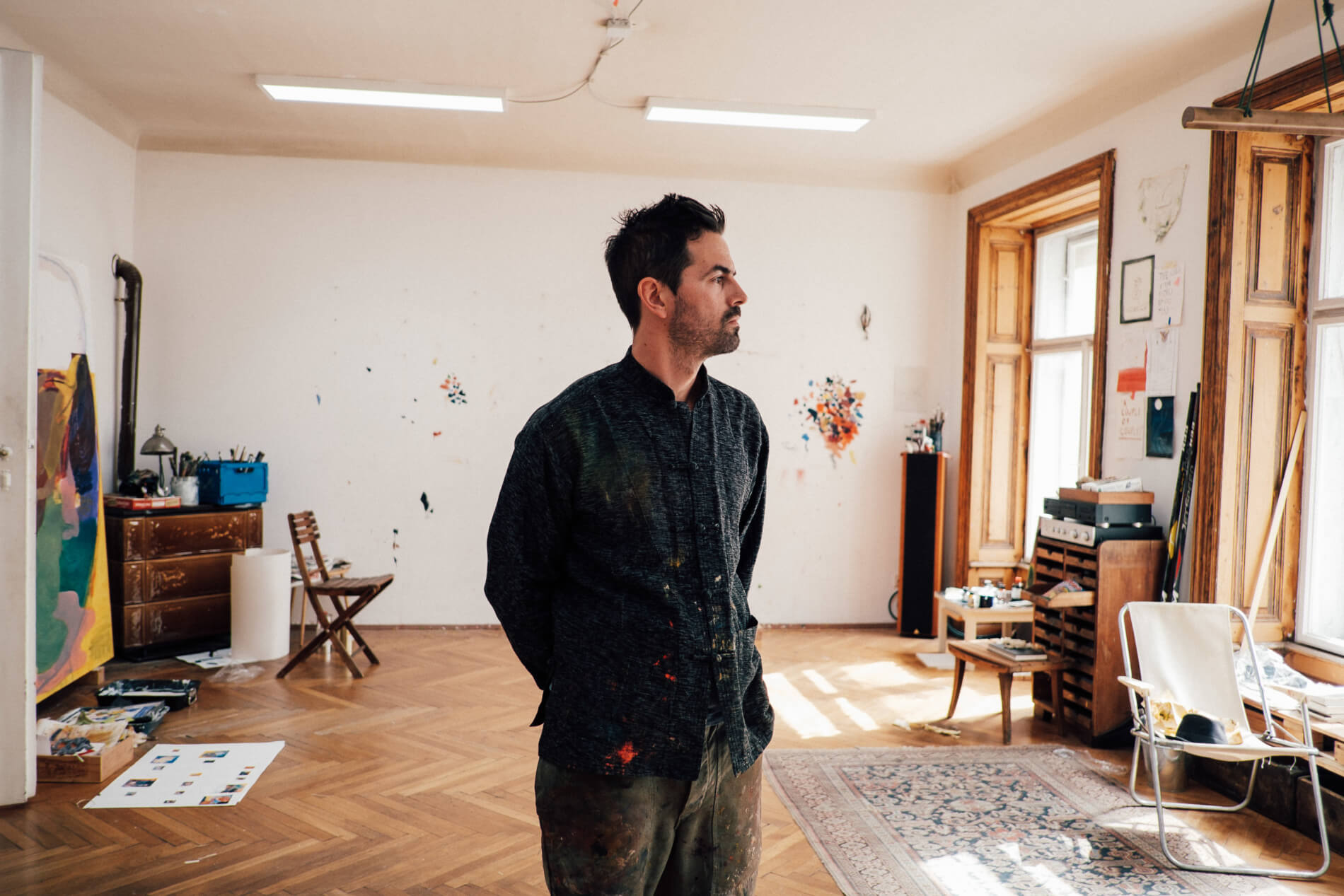
Stature of Waiting is a collection of paintings and drawings by Vienna-based artist Daniel Domig. In looking at these, it can be hard to know what we’re seeing. This should come as no surprise since Daniel explains that “waiting for the work to appear” is the primary posture he maintains in the studio.
We strain our eyes to register organic shapes and features among the colors. Sometimes we find a face. But invariably something seems amiss – an arm (or is it a leg?) bends in an impossible direction. What we thought was a body now seems to be unraveling. It is here that the work can begin to feel unsettling.
But it is also here that we might lighten up. As Daniel suggests, we could content ourselves with not understanding a work even as we spend more and more time in front of it. We could “just sit and read a book or have a conversation” in its presence.
So here’s a conversation. Our guest curator, Josh Welker, in dialogue with Daniel to learn more about his practice and some of the context behind these works, beginning with the title, Stature of Waiting.
I read The Stature of Waiting pre-pandemic and was really impressed by Vanstone’s ideas of what it means to be passive in a time where production is everything and we often do something simply for the sake of doing something. It was very present to me during the pandemic.
It’s not an easy thing to practice. It is one thing to agree with Vanstone that waiting is fine. But we all carry a sense of this necessity of making ends meet. If we stop doing what we’re doing, we’re quite literally losing money. Or we feel we’re losing the chance to take that next step towards a bigger apartment, house, or career. It’s a sense that if we’re not active then we’re going backwards.
Non-action is an action against ourselves.
If I take this concept and reduce it down to the place where I spend most of my time—in the studio, waiting to see what happens, contemplating life, and trying to understand what it means to make art—it’s a real challenge. I want to have something to show, not only for me but for my wife who is juggling the kids while I’m there. I still find this very hard.
Very close. I am desperately trying to understand painting not so much as the artist creating his picture onto an empty canvas, but painting ultimately in dialogue with the process of negotiating form. When do you find a recognizable shape? At what point do you look at something and say “this is a form,” be it abstract or figurative?
Considering the process of looking within Vanstone’s language of waiting is something that I’ve attempted to cultivate with every act of painting.
If someone were to watch me paint, it would be the worst performance ever. There are forms and colors. There are drips. But it comes from months and months of frustration—of feeling like nothing is coming. This is often hidden in the painting.
Waiting is not only part of the process of making (and finishing) a painting, it also becomes part of viewing the painting. I’m trying to create works that are so full of the unfolding of forms that even when the work is finished an owner will still find things happening in the painting. They’ll come home from vacation and say “something is different.”
Waiting is incorporated into the painting, and there is a sense that it is worth waiting for the work to appear.
I like to explain the work of the artist in relation to Genesis—of Adam being the first artist in the form of a gardener. As a gardener your main job is to create the proper conditions for growth. A lot of your energies go into understanding dirt. Your job is to keep it moist, flexible, and good for things to make roots. You even introduce nasty stuff like worms to produce the sort of earth that visible stuff will come out of.
I think of this whenever I get any sort of praise for a finished work—it’s like a gardener getting praised for his roses. But he didn’t create any of that. His job was digging in the dirt. This reminds me that in some ways the better you do the invisible work (and often there’s nothing to show for it except dirty hands!), then in the long run the more growth you will have in areas that somehow come about by themselves.
This requires a lot of patience.
Some days you handle the dirty work better. And then there are days where you do something artificial or contrived. This is like a gardener saying, “I don’t want to work with the dirt. I want roses!” The only way you’ll get roses without working in the dirt is by making artificial roses or buying them.
The same way a gardener will forget to stop and enjoy the roses, you need someone to come in who hasn’t done the work and comment on the beauty that has flourished. You need someone else. I will look at them looking at the work and try to see what they see because I can’t see it myself. I need this moment that the viewer provides, often standing in silence.
I have no problem talking about the work, but I find myself waiting for what the person who is new to the work will see. Whatever I have found is not equal to what this new encounter will bring to the work.
I think this is a true thing about aesthetic experience in general—it is very hard to have them by yourself.
Bringing others into this space of waiting together, and the act of sharing patience—in silence, or in mutual questioning, or expectation of something to happen—this is something really beautiful.
In German we have the word “Jein” which is yes (ja) and no (nein) together.
Our culture is so individualistic. Really the idea that you have any experience outside of being shaped by your community is absurd. You’ve experienced this in public. In a subway station, a baby is doing something cute, and you can lock eyes with a stranger and be in agreement. Not only are you in agreement, but you need the agreement to fully understand what is going on.
When it comes to beauty, your eyes are the least important thing. It’s the eyes and words of the people around you sharing the experience that will actually make it a reality.
I barely get bored anywhere. I like looking and talking to people; listening and waiting in life. When I go to the studio, I do the same thing. The only difference is, I’m in the studio, and I have a brush and paint. I’m really not interested in pictures at all but in something else. Sometimes I can doubt if I’m even a painter, or someone who might have been, in a different life, a Trappist monk. I landed with four kids and a wife as a painter, but it could be something else, and I would be fine. My soul would have the same stature of waiting towards the world.
I think the only thing I would probably recommend (tying back into this importance of community) is to invite someone else into the space, move some chairs in close proximity, and just talk. My experience is that art gives you a good chance to talk about things that you would otherwise only talk about in therapy sessions. I’ve been with friends in front of works, and we end up talking about God, death, failing marriages.
If someone asks how to approach a painting, I would say don’t approach it. I would say be near it and do something there. Just sit and read a book or have a conversation.
The point is not to understand them. I don’t even understand them.

“To man as he waits the world discloses its power of meaning—discloses itself in its heights and its depths, as wonder and terror, as blessing and threat. Man becomes, so to speak, the sharer with God of a secret—the secret of the world’s power of meaning. The world is for him no mere succession of images recorded and registered in the brain: it is what Blake saw in his tiger and Kant in the starry heavens—a wonderful terror or a terrifying wonder. Rarely does man rise to such intense receptivity; but even in quite ordinary moments he becomes a point at which something in the world is not only registered but understood, experienced, recognized. Because man is in the world there are points in the world at which things no longer merely exist but are understood, appreciated, welcomed, feared, felt. Man as he waits upon the world become a place where the world is received not as it is received by camera or a tape-recorder but rather with the power of meaning with which it is received by God.”
W. H. Vanstone
A musical companion to the exhibit, these songs-curated by Daniel-represent some of the sounds filling his studio of late.